
The number of allergies is increasing every year, and the reasons for this growth can not be explained either by therapists or allergists. If earlier each offseason brought only 12% of new patients, now this figure has increased several times. These are only statistical data of the journal "Health".But how many people still do not go to hospitals with allergies just because they have never been allergic. Not everyone knows that the human body changes with age so that a completely healthy person can become allergic.
Various factors can trigger the reaction, right up to the air conditioner. Depending on the irritant and body, the disease can manifest itself as an allergic rhinitis.
Content
- 1 Features disease
- 2 Types
- 3 disease Possible causes and predisposing factors
- 4 first signs and symptoms
- 4.1 Diagnostics
- 5 Treatment
- 5.1 Medicines
- 5.2 Folk remedies
- 6 Prevention
- 7 Consequences and complications
- 8 Video
Features
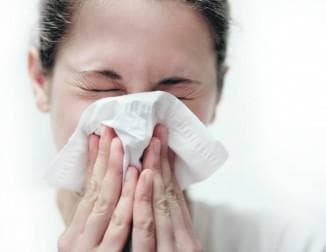 disease Allergic rhinitis( codein μb 10 - J30) means inflammation and swelling of the mucous membrane of the sinuses of the nose. At the same time, there must be one or all of the features of such a cold:
disease Allergic rhinitis( codein μb 10 - J30) means inflammation and swelling of the mucous membrane of the sinuses of the nose. At the same time, there must be one or all of the features of such a cold:
- sneezing;
- obstruction of the nose;
- itching in the nose;
- tear;
- rhinorrhea( clear discharge).
One of these signs should manifest itself every hour. Otherwise, we are dealing with a different kind of rhinitis, for example, with a vasomotor form. The course of allergic rhinitis has four stages:
- Vasotonic stage of : the nose is filled with episodes, the vascular tone is changed, infrequent instillation is required;And here's how vasomotor rhinitis is treated, you can find out by reading this article.
- Vasodilation : congestion is more dense and frequent, the vessels are dilated, it is difficult to breathe without medicine;
- Chronic edema : the nose is laid, the mucosa becomes a blue tone, the drops and sprays have no effect;And here's how the swelling of the nasal mucosa without a runny nose is treated, you can understand by reading the article.
- Hyperplasia : the nose is always laid, polyps appear, it is fraught with secondary diseases( otitis, infections).
Types of the disease

All-the-year-round allergic rhinitis alternates year-round in accordance with the scheme: exacerbation-remission
The most common allergic rhinitis is associated with seasons, but this is not an axiom. The rhinitis is divided into several groups:
- seasonal;
- chronic all-the-year-round;
- sharp.
Each species is characterized by the severity of symptoms, different states of patients. With seasonal rhinitis, the disease manifests itself only in the off-season, when the flowering of plants and trees is active. Year-round chronic has a permanent form, the whole year the disease alternates according to the scheme: exacerbation - remission.
 What kind of drops in the nose for allergic rhinitis is best used, this article.
What kind of drops in the nose for allergic rhinitis is best used, this article.
How the rhinitis of pregnant women is treated is indicated in this article.
How is the treatment of vasomotor rhinitis at home, indicated in the article here: http: //prolor.ru/n/ bolezni-n /rinit/ vazomotornyj-lechenie-v-domashnix-usloviyax.html
Acute rhinitis usually occurs after contact with a sudden stimulus. For example, the chronic can go into the acute phase when exposed to an aggressive allergen. The acute form is also divided into varieties:
- traumatic, in which the rhinitis begins as a protective reaction to damage;
- is infectious, inflammation develops from the ingress of a bacterium or a virus;
- is allergic, in which an aggressive agent attacks.
Allergic rhinitis in acute form proceeds actively, aggressively, sometimes for a long time. Even with the proper treatment, one can persistently torture the patient and, on top of everything, go into asthma. Therefore, the acute form is considered the most dangerous to health.
Possible causes and predisposing factors
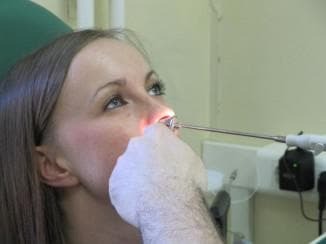 Allergies are classified as inherited diseases or predispositions. For example, in the genus there may be asthmatics, which indicates the possibility of transferring a predisposition to allergies to each relative. It is not necessary to develop the disease to bronchial asthma, but the very presence of a reaction to potential allergens will manifest itself.
Allergies are classified as inherited diseases or predispositions. For example, in the genus there may be asthmatics, which indicates the possibility of transferring a predisposition to allergies to each relative. It is not necessary to develop the disease to bronchial asthma, but the very presence of a reaction to potential allergens will manifest itself.
Often the predisposing moment is one of the following:
- curvature of the nasal septum;
- presence of polyps in the nose;
- persistent colds;
- increased permeability of the shell itself;
- metabolic disorders;
- changes in liver function.
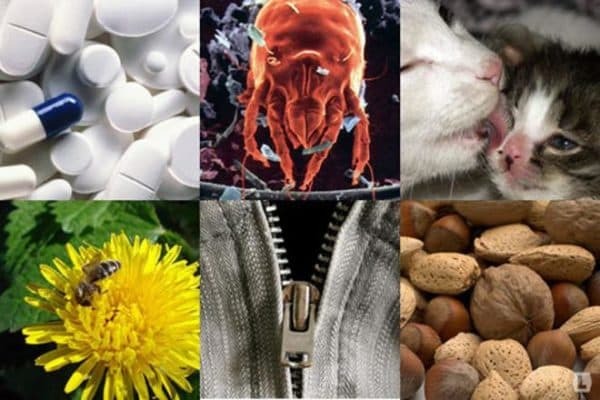
Pollen of plants, animal hair, food - the list of allergens can be extensive
Many factors can become the causes of allergy, much depends on the individuality of the organism and the tolerance:
- dust, dust mites;
- flowering plants;
- animal wool;
- insect bites;
- contact with odors;
- intolerance to certain foods;
- reaction to taking drugs;
- air conditioner.
Usually, an allergic knows well what exactly provokes his disease. For example, honey, milk, eggs belong to highly allergenic foods, like chocolate. As can be seen, it can be difficult to find the cause, but it is still possible by exclusion.
Perfumes, deodorants, a range of products can easily cause allergic rhinitis.
First signs and symptoms of
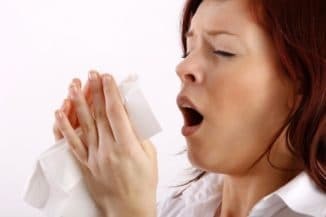 Usually allergic rhinitis is active in the morning: the patient sneezes for a long time, coughs. The first signs can sometimes be seen immediately, but it depends on the situation. For example, if sprays were sprayed and a person began to sneeze heavily, then this is his allergen. In others, the common cold starts when you contact a cat or dog. It must be said that allergic rhinitis is reactive, it does not wait long and rarely "sits in ambush".If the agent is in the nose, the mucosa immediately starts trying to get rid of the foreign body. Therefore, the patient begins to sneeze, it itches in the nose, clear mucus is released.
Usually allergic rhinitis is active in the morning: the patient sneezes for a long time, coughs. The first signs can sometimes be seen immediately, but it depends on the situation. For example, if sprays were sprayed and a person began to sneeze heavily, then this is his allergen. In others, the common cold starts when you contact a cat or dog. It must be said that allergic rhinitis is reactive, it does not wait long and rarely "sits in ambush".If the agent is in the nose, the mucosa immediately starts trying to get rid of the foreign body. Therefore, the patient begins to sneeze, it itches in the nose, clear mucus is released.
Allergic rhinitis may appear not one, but bring with itself a secondary disease .Most often it is otitis media, less often bacteria and infections. To treat such a bunch is difficult, because one disease complicates the other.
With a clean rhinitis, the discharge from the nose is transparent, easily separated.
If the rhinitis is started, secondary diseases have joined, then the discharge from the nose will turn yellow or green, it will be hard to breathe, the nose is very itchy. But such a current is more characteristic of chronic all-the-year-round form, rather than for acute seasonal rhinitis.
Diagnosis

With the help of a special device the doctor examines the sinuses of the nose, determining the degree of damage and edema of the
. The primary diagnosis is based on the patient's complaints and his story: the rhinitis time, manifestation, flow characteristics. Then, using a special device, the doctor examines the sinuses of the nose, determining the degree of damage and swelling. If the situation is severe and requires clarification, then a rhinoscopy is indicated. Rhinoscopy is an accurate study that allows you to view nasal cavities in different projections.
If you are talking about a sudden allergy in an acute form, the doctor takes a piece of skin for testing. This allows you to identify a malicious agent and name the exact cause of allergic rhinitis.
Treatment
Medications
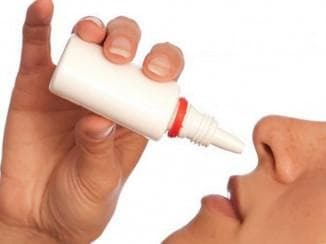 Therapeutic regimen is determined only by the specific condition of the patient and the cause that caused the runny nose. Usually, in mild form, an angiystamine is prescribed: Claritin, Zirtek. If necessary and the presence of nasal obstruction, sprays such as Otrivin( All about otryvin or nasivin for children, can be found here in the article.) Are used to facilitate breathing, especially at night. It is imperative to rinse the sinuses with saline solution to remove puffiness from the mucous membrane and disinfect it.
Therapeutic regimen is determined only by the specific condition of the patient and the cause that caused the runny nose. Usually, in mild form, an angiystamine is prescribed: Claritin, Zirtek. If necessary and the presence of nasal obstruction, sprays such as Otrivin( All about otryvin or nasivin for children, can be found here in the article.) Are used to facilitate breathing, especially at night. It is imperative to rinse the sinuses with saline solution to remove puffiness from the mucous membrane and disinfect it.
More severe forms are treated individually. In combination with antihistamines, antagonists of the Acolate type can be prescribed. Some people are recommended special food, for example, the complete exclusion of food allergens. Depending on what type of pollen allergic rhinitis may be prohibited from eating such foods as nuts or apples.
If the effectiveness of treatment is zero, then special therapy can be shown, which makes it possible to develop immunity to a specific allergen. But this long-term treatment takes up to five years.
To preparations of new generation, more powerful and effective, carry such as Lordestin, Zodak Express, Desloratadine-Teva. These drugs have reduced side effects, for example, drowsiness. In this case, the effect comes much faster, for example, when taking Zodak Express, the first relief is felt after 15 minutes. H o need to make a caution: the new generation of drugs has other chemical lines of connections, so intolerance is possible.
Folk remedies
 For the patient it is necessary to ensure strict conditions:
For the patient it is necessary to ensure strict conditions:
- cleanliness and wet cleaning;
- exclude communication with any animal;
- do not use perfume, fresheners;
- constantly air the room.
Well-known recipes from the common cold at home, for example, a decoction from the collection of herbs: elecampane, centipedes, St. John's wort and dog rose. The last one is to be milled separately. All the herbs in equal parts to mix, you can add 2 spoons of dandelion. Pour 400 g of hot water and put on one day. In a day, get it, boil it and immediately remove it. Tightly wrap for 4 hours and leave. Drink 1/3 cup twice a day, the course for six months.
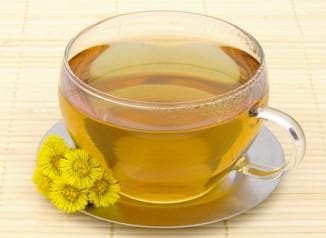 It will be useful to brew mother-and-stepmother with chamomile. Also in equal portions, mix, boil, allow to pour for a few minutes and remove. When it cools, drain and let cool. Drink 1/2 cup twice. The same composition can be used for inhalation. Only chamomile should be slightly larger: 200 g of mother-and-stepmother and 250 g of chamomile. It is necessary to give a boil, remove from heat, cover with a thick towel and actively breathe the emitted steam. It is very effective if the patient often complains of stuffiness.
It will be useful to brew mother-and-stepmother with chamomile. Also in equal portions, mix, boil, allow to pour for a few minutes and remove. When it cools, drain and let cool. Drink 1/2 cup twice. The same composition can be used for inhalation. Only chamomile should be slightly larger: 200 g of mother-and-stepmother and 250 g of chamomile. It is necessary to give a boil, remove from heat, cover with a thick towel and actively breathe the emitted steam. It is very effective if the patient often complains of stuffiness.
Alternatively, you can use nebulizers. The device can fill any composition and breathe freely into the mask, which is much more convenient. If you do not have any herbs at hand, you can make inhalation from a simple validol. In boiling water put crushed 3-5 tablets and begin the procedure.
The simplest inhalation is inhaling steam from boiled potatoes. The old method is often the most effective in treating any runny nose.
However, it should be remembered that some national recipes quickly cure a runny nose from an adult will not work.
Prevention
The best way to avoid problems with allergic rhinitis is to stay away from an aggressive agent. There's no other way to save yourself. As an additional option - a thorough washing of the nose with salt in case of probable contact with the allergen.
Consequences and complications
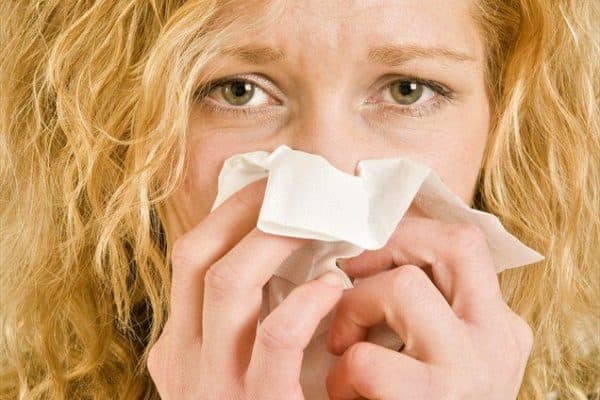
Genyantritis, asthma, allergic cough - few complications of allergic rhinitis
Untreated allergic rhinitis inevitably leads to the appearance of secondary diseases:
- otitis;
- bronchial asthma:
- allergic cough;
- dermatitis;
- sinusitis, sinusitis;
- conjunctivitis.
Runny nose can become chronic, and the treatment of chronic allergic rhinitis is a very long and time consuming process.
Video
Learn more about the diagnosis of allergic rhinitis:
Allergic rhinitis is painful, it prevents living a normal life. But timely treatment, the adequacy of measures and the identification of the type of agent will reduce the aggressiveness of seizures. And sometimes you can completely eliminate the problem, if everything is done correctly and in due time.
